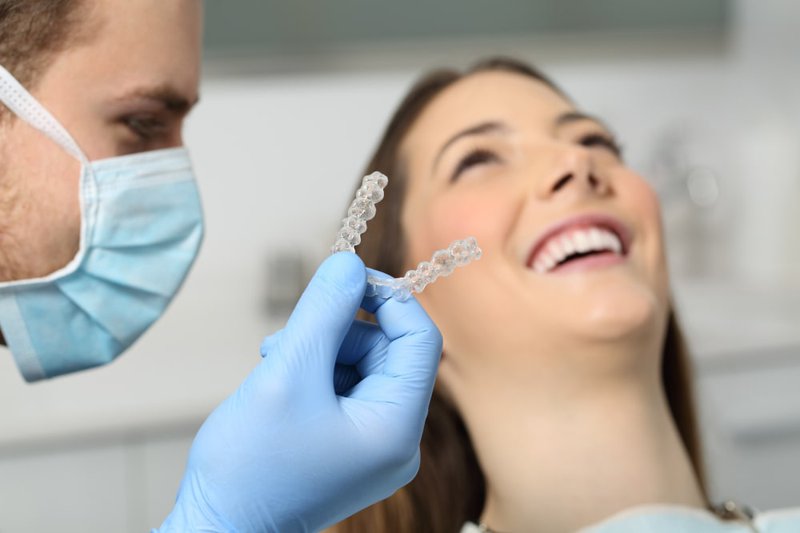
Invisalign vs. Braces: Which Is the Right Choice for You?
Key Takeaways
- Invisalign vs braces is a decision based on more than appearance—it also affects comfort, oral hygiene, and lifestyle.
- Invisalign is clear, removable, and discreet; braces are fixed, visible, and ideal for complex cases.
- The right choice depends on your lifestyle, orthodontic needs, and personal preferences.
- A consultation with an experienced orthodontist is key to choosing the best option for your unique smile.
Choosing the Best Path to a Straighter Smile
Straightening your teeth isn’t just about a beautiful smile—it’s about oral health. Correcting misalignment helps prevent decay, gum disease, and jaw pain. Today, the most popular treatments are Invisalign vs braces. Both are effective, but they work differently and offer unique advantages.
How They Work: The Science Behind Invisalign and Braces
Both Invisalign and braces apply controlled pressure to reposition teeth—but the tools and techniques differ significantly.
While braces use metal or ceramic brackets and wires to gradually shift teeth into alignment, Invisalign uses clear plastic trays (aligners) that are custom-made to fit your teeth and gently move them over time.
The following table breaks down the difference between Invisalign and braces, and why choosing the right method starts with understanding how they work.
| Feature | Braces | Invisalign |
|---|---|---|
| Appearance | Visible (metal or ceramic) | Nearly invisible |
| Removability | Fixed in place | Removable |
| Adjustments | Wire tightening every 4–6 weeks | New aligners every 1–2 weeks |
| Eating restrictions | Yes | None (remove to eat) |
| Oral hygiene | Challenging with brackets | Easier—aligners are removable |
| Suitable for | Mild to severe cases | Mild to moderate cases |
"Some patients need the control of braces, while others love the freedom of Invisalign. We guide them toward what will give the best outcome," says Dr. Jerry Jesin at North York Smile Centre.
Aesthetic Appeal: Discreet or Classic?
Appearance plays a big role in the braces vs Invisalign debate. Many people, especially teens and professionals, prefer a discreet orthodontic solution. Invisalign is virtually invisible, making it popular among those who prefer a low-profile solution. Braces, while more visible, now come in options like tooth-coloured ceramic, making them less noticeable than before. It’s a key part of the Invisalign pros and cons comparison.
Invisalign
- Made from clear, medical-grade plastic
- Almost invisible during day-to-day interactions
- Often chosen for the social confidence it brings

Braces
- More noticeable, but now available with ceramic or tooth-coloured brackets
- Braces can be personalized with coloured elastics for younger patients
When evaluating Invisalign pros and cons, aesthetics is one of the biggest advantages in favour of aligners.
Comfort and Daily Life: Which One Feels Better?
Daily wearability is essential. Here’s how aligners vs braces compare in terms of comfort and convenience.
Invisalign trays are smooth and removable, making them less irritating to cheeks and gums. Braces, especially in the first few days after tightening, can cause soreness or discomfort.
Invisalign
- Smooth plastic trays mean fewer mouth sores or irritation
- Can be removed during meals, sports, or special events
- No dietary restrictions
- May cause a slight lisp in the first few days
Braces
- Metal or ceramic brackets can irritate cheeks and lips
- Some discomfort after adjustments (tightening)
- Eating requires more caution to avoid damaging hardware
Braces are always on—but Invisalign gives you the freedom to remove your aligners when needed, making them feel less invasive to daily life.

Effectiveness: Which One Delivers Better Results?
Is Invisalign better than braces? It depends on your specific orthodontic needs. Invisalign works well for mild to moderate issues—like crowding or small gaps—but may not be suitable for severe misalignment or bite correction. Invisalign requires patients who can commit to 20–22 hours of daily wear.
Braces are often more effective for:
- Complex bite issues
- Severely rotated teeth
- Teeth requiring vertical movement
- Patients who may not be compliant with removable trays
Invisalign vs braces, which is faster? Treatment time varies. Invisalign is usually 12–18 months, while braces range from 18–24 months—but both depend on the case and patient compliance.
Maintenance and Oral Hygiene: Which Is Easier to Manage?
Oral hygiene matters during orthodontic treatment. Here's how each system holds up.
Brushing and flossing around brackets and wires can be tricky. Invisalign makes this easy since aligners can be removed. However, you must wear them for 20–22 hours daily to see results.
Risks:
- Braces: Increased plaque buildup and risk of cavities, if not cleaned properly.
- Invisalign: Must clean trays regularly to avoid staining and odour.
Braces:
- Can make brushing and flossing tricky
- More risk of plaque buildup around brackets
- Requires special tools (e.g., floss threaders)
Invisalign:
- Trays are removable, so brushing and flossing is much easier
- Must clean aligners daily to prevent staining and odour
- No food restrictions, but trays must be worn most of the day

Cost and Insurance: Understanding the Investment
When comparing Invisalign vs braces cost, the price is often similar. However, costs can vary based on:
- Complexity of the case
- Length of treatment
- Dental provider
Some insurance plans cover orthodontic care regardless of method. Many clinics, including North York Smile Centre, offer payment plans to make treatment accessible.
Braces:
- Can make brushing and flossing tricky
- More risk of plaque buildup around brackets
- Requires special tools (e.g., floss threaders)
Invisalign:
- Trays are removable, so brushing and flossing is much easier
- Must clean aligners daily to prevent staining and odour
- No food restrictions, but trays must be worn most of the day
When comparing braces or Invisalign, oral hygiene is one of the clear wins for Invisalign.

Cost and Insurance: Understanding the Investment
The Invisalign vs braces cost is often similar, though small differences can arise based on:
- Case complexity
- Length of treatment
- Your dental provider's experience and location
Insurance
Many dental plans cover both treatments. Some may contribute a fixed dollar amount toward orthodontic care, regardless of method. Be sure to check with your provider for details.
Financing
Clinics like Smile By Design offer flexible payment plans, making your treatment more accessible.
What’s Best for Your Needs?
What does Invisalign do best? It provides discreet, flexible treatment for mild to moderate orthodontic issues. Braces, however, can tackle a wider range of problems and require less daily discipline from the patient.
Ultimately, the best option depends on your oral health, lifestyle, and commitment. It’s important to meet with an experienced orthodontist to weigh your options.
You’ve seen the pros, cons, and facts—but how do you choose?
Consider the following
- Your lifestyle: Will you wear trays consistently?
- Your case complexity: Mild crowding or a deep overbite?
- Your habits: Are you prone to snacking or forgetfulness?
- Your budget: Do you have insurance or need financing?
The best way to decide between braces or Invisalign is to consult a qualified orthodontist. Your provider will assess your smile, discuss your goals, and recommend a treatment tailored just for you.
Invisalign at North York Smile Centre
At North York Smile Centre, we offer expert Invisalign treatment designed for your life. From digital scans to customized aligners, we ensure a comfortable, modern, and effective experience.
"Invisalign offers flexibility without compromising results. With proper compliance, it can be just as effective as traditional braces," says Dr. Jerry Jesin.
We’re committed to helping you achieve your best smile—through the method that fits you best.
FAQs: Common Questions About Invisalign vs Braces
Q: What is Invisalign?
A: Invisalign is a clear aligner system that straightens teeth using a series of removable trays.
Q: What does Invisalign do that braces can’t?
A: Invisalign is nearly invisible and removable, allowing you to eat freely and maintain better oral hygiene.
Q: Invisalign vs braces cost—what should I expect?
A: Costs are often similar, but depend on treatment length and complexity. Check with your provider for specifics.
Q: Is Invisalign better than braces?
A: For mild to moderate cases, yes. But severe misalignment may still require braces.
Q: What’s the difference between Invisalign and braces?
A: Invisalign uses clear trays; braces use fixed brackets and wires. Invisalign is removable—braces are not.
Q: Should I get braces or Invisalign?
A: It depends on your dental needs and lifestyle. Your orthodontist will help guide you to the best choice.
Curious which path is right for you? Visit our News & Blog or schedule a consultation at North York Smile Centre today.
Additional Resources:

